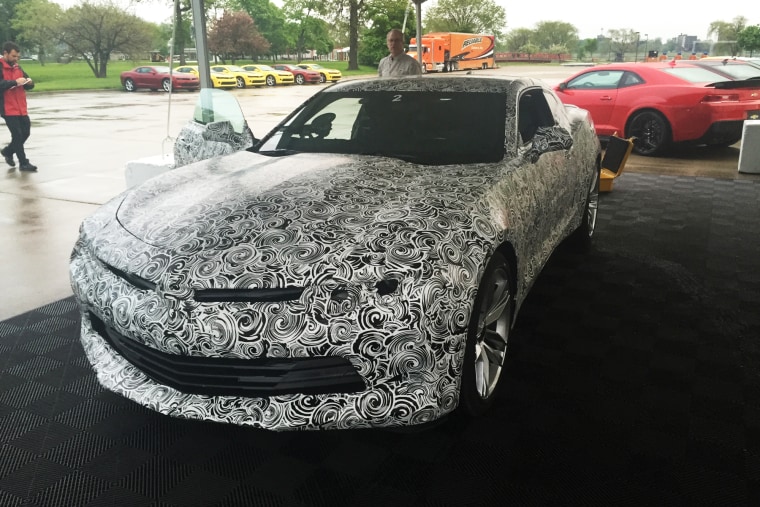Coming up with an all-new name has become a major headache for automakers around the world. It can be difficult to find a name that hasn’t already been taken, and it then can be extremely costly to build consumer awareness for a new moniker.
So a number of carmakers are looking back into their past to see if there are once-popular nameplates that can be revived. And after the successful revival of the Chevrolet Camaro a few years back, it appears even more manufacturers are going to take this route.
Among the once-popular names we may soon see back in showrooms are the Grand Wagoneer, Barracuda, Ranger and Bronco. Others may follow – though looking for a blast from the past does carry some risks, industry analysts warn.

As TheDetroitBureau.com reported this week, Ford Motor Co. is expected to bring back the Ranger pickup, a nameplate it abandoned in the U.S. in 2011, though it continued offering an all-new model overseas. The Ranger would fill a gap in Ford’s line-up now that there are signs American motorists are returning to the once-huge midsize truck segment.
The revival of the Ranger would follow the return of the Chevrolet Colorado and GMC Canyon models, both of which briefly went out of production while General Motors worked up a more modern and competitive redesign of the compact trucks.
Ford also is said to be toying with the return of another once-popular model, the Bronco SUV. It was once a leader in the sport-utility segment but was replaced by more car-like models, such as the Ford Explorer. A new Bronco, sources suggest, would be roughly the size of the latest Explorer, but instead of riding on a car-like crossover platform it would share the chassis of the new Ranger pickup.
Think Small, Aim High: Smart Car Pins Hopes on New Microcar Models
Fiat Chrysler Automobiles has brought back a number of model names in recent years, including muscle car mainstays like the Dodge Charger and Challenger. And it may add one more old-is-new offering to that high-powered segment, a revived Barracuda. In its heyday, the ‘Cuda was marketed through the now-abandoned Plymouth brand. Going forward it would be sold through Dodge.
The sibling Jeep brand is also expected to bring back an old model, the big Grand Wagoneer. Though often credited with creating the modern SUV boom, Jeep hasn’t kept up with some key rivals in filling every possible model niche. The revived Grand Wagoneer would be a full-size model to take on the likes of the Mercedes-Benz GL, among others.
FCA reportedly is filling in dealers on its future product plans during a meeting in Las Vegas. Ford, meanwhile, has reportedly clued in the United Auto Workers Union on some of its plans as part of its ongoing contract negotiations. Formal public announcements could follow in the weeks or months ahead.
There are several reasons why manufacturers reach into their histories to revive old nameplates. For one thing, it is becoming increasingly difficult to come up with good names that aren’t already in use or at least registered by a competitor. That’s one reason many makers have gone the alphanumeric route. But they also know that it’s hard to get worked up about something called an ABC123.
New Jeep Cherokee Model to Get 707-HP Hellcat Engine, Sources Say
Launching an all-new nameplate, meanwhile, is extremely expensive. A mainstream model often requires a marketing investment of $100 million or more to establish it, notes analyst Joe Phillippi, of AutoTrends Consulting.
But when it comes to these blasts from the past, some of those old model names still carry a lot of positive heritage that automatically tells a story in the collective public mind. That was the case when General Motors brought back the Chevrolet Camaro in 2009. The muscle car went on to dominate the so-called pony car segment for the next five years.
On the other hand, GM’s effort to bring back the once-revered Pontiac GTO name flopped a decade ago. Unlike the retro-styled Camaro, the new “Goat” had a bland and largely forgettable design that failed to connect with consumers.
That also was the case with the Thunderbird, the two-seat roadster Ford tried to launch a decade ago. Over the decades, the T’bird went through a variety of incarnations, from the original two-seater to a bloated coupe and then into a quirky but less-than-compelling two-seater again. A variety of product weaknesses resulted in mixed reviews and weak sales, and the Thunderbird was again pulled from the market.
So, while a grand old name can give a new product a head start, it’s not enough to fix a bad vehicle design.
More from The Detroit Bureau
Lawsuit Targets 10 Major Automakers, Claims Deadly Keyless Ignition Defect
Automakers Rapidly Expand Availability of Crash Avoidance Technology